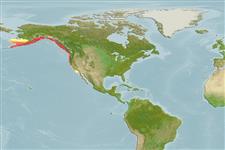Environment: milieu / climate zone / depth range / distribution range
экология
морской демерсальный; oceano-estuarine (Ref. 51243); пределы глубины 0 - 475 m (Ref. 6793). Temperate; 61°N - 31°N, 172°W - 116°W
Northeast Pacific: Shumagin Islands in the western Gulf of Alaska to Ensenada, Baja California, Mexico. Possibly occurring in the Bering Sea (Ref. 6793).
Length at first maturity / Size / Вес / Возраст
Maturity: Lm 70.5, range 61 - 76 cm
Max length : 152 cm TL самец/пол неопределен; (Ref. 2850); наибольший вес (опубликованные данные): 59.1 kg (Ref. 40637); наибольший возраст (опубликованны данные): 25 годы (Ref. 55701)
колючие лучи спинного плавника (общее число): 24 - 27; членистые (мягкие) лучи спинного плавника (общее число): 21-24; колючие лучи анального плавника 3; членистые (мягкие) лучи анального плавника: 21 - 24; позвонки: 55 - 59. Anal spines of adults buried in flesh, third spine closely applied to first ray (Ref. 6885). Head without scales; fleshy cirrus above each eye; large mouth; maxilla reaching almost to vertical from posterior margin of eye. Jaws with small pointed teeth interspersed with large fanglike teeth (Ref. 48751).
Ranges from the intertidal to 475 m depth (Ref. 6793). Adults are found near rocks, inshore and to 427 m (Ref. 2850). Young occur on sand or mud bottom of bays and inshore areas (Ref. 2850). Both migratory and non-migratory populations exist (Ref. 6885). Adults feed mostly on other fishes but also take crustaceans, octopi and squid (Ref. 4925). Young feed on copepods and other small crustaceans (Ref. 6885). A very important sport and commercial species (Ref. 2850). The liver is rich in vitamin A (Ref. 6885). Marketed fresh and frozen; eaten steamed, fried, broiled, boiled, microwaved and baked (Ref. 9988). Has sharp teeth and gill rakers that can cut fingers if handled.
Eggs are deposited in crevices or under rocks (Ref. 6885). Male guards the eggs until they hatch.
Eschmeyer, W.N., E.S. Herald and H. Hammann, 1983. A field guide to Pacific coast fishes of North America. Boston (MA, USA): Houghton Mifflin Company. xii+336 p. (Ref. 2850)
Статус Красного Списка МСОП (Ref. 130435)
Угроза для людей
Traumatogenic (Ref. 13513)
Использование человеком
рыболовство: коммерческий; объект спортивного рыболовства: да
дополнительная информация
инструменты
Специальные отчеты
Скачать в формате XML
ресурсы в Интернет
Estimates based on models
Preferred temperature (Ref.
123201): 4.5 - 8.6, mean 5.9 °C (based on 184 cells).
Phylogenetic diversity index (Ref.
82804): PD
50 = 1.0002 [Uniqueness, from 0.5 = low to 2.0 = high].
Bayesian length-weight: a=0.00389 (0.00180 - 0.00842), b=3.12 (2.94 - 3.30), in cm total length, based on all LWR estimates for this body shape (Ref.
93245).
Trophic level (Ref.
69278): 4.5 ±0.6 se; based on diet studies.
устойчивость к внешним воздействиям (Ref.
120179): средний (среднего размера), минимальное время удвоения популяции 1.4-4.4 года (tm=4; tmax=25;).
Prior r = 0.48, 95% CL = 0.32 - 0.73, Based on 1 stock assessment.
Fishing Vulnerability (Ref.
59153): High vulnerability (56 of 100).
Climate Vulnerability (Ref.
125649): Moderate to high vulnerability (48 of 100).
Nutrients (Ref.
124155): Calcium = 25.5 [9.8, 54.9] mg/100g; Iron = 0.351 [0.157, 0.792] mg/100g; Protein = 18.3 [16.1, 20.3] %; Omega3 = 0.589 [0.263, 1.706] g/100g; Selenium = 28.4 [14.8, 68.4] μg/100g; VitaminA = 9.37 [2.88, 31.89] μg/100g; Zinc = 0.289 [0.192, 0.446] mg/100g (wet weight); based on
nutrient studies.
